When you want to go to a new place where you have never been before you have to become familiar with the terms which are commonly used. It is the same thing when facing the loading dock world. Having the right knowledge of it will help you to break the communication barrier between the people involved in this industry and yourself. When you need to talk about a specific concern or have an inquiry related to your loading dock equipment and operations, reading the loading dock glossary terms below will help you communicate in a more comfortable way.
Loading Dock Glossary of Terms:
- Attachments: This term is used for the implements that can be added to a fork truck when you need to handle a load. They should be considered when you have to select your dock leveler as they have an effect on capacity. There are several attachments such as:
- Clamps
- Slip sheet
- Forks
- Carpet poles
- Barrier Vehicle Restraint: The part of a vehicle that engages the transport vehicle in order to avoid movement.
| - Bumpers, Dock: To make a cushion effect in the building from truck trailer impact, loading dock bumpers are made of rubber or any other material (resilient) and are normally located at the floor level of a dock opening. | 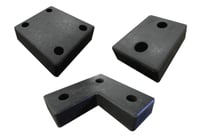 |
| - Chocks: It's to avoid movement of the vehicle away from a loading dock, a wheel of a transport vehicle should be set in front of a wheel chock. | 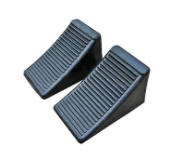 |
| - Communication Light System: For communication of the loading operation to the dock operation and to the driver of the transport vehicle, colored lights are needed. Two sets of lights are recommended. The first one will indicate to the dock operator whether the restraint is engaged and the second one will indicate the driver of the transport vehicle whether it is safe to pull the vehicle away from the dock. For indicating GO, light green is used and red for STOP. | 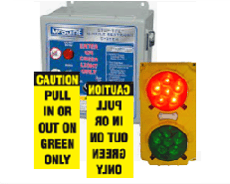 |
- Curb Angle: These are used to reinforce and protect the corner edges of the pit area or the face edge of a dock.
- Dawg A: It is a toothed item that when engaged with a ratchet bar, limits only to one direction the travel of the bar.
| - Dock/Dock Bay: It is used when shipments need to be loaded or unloaded. It is a staging platform. | 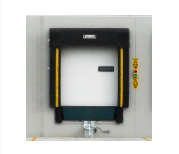 |
| - Dockboard: Mechanism used between the warehouse and/or a loading dock platform and a vehicle’s load bed for bridging the gap. | 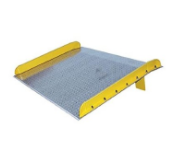 |
| - Dock Bumper: These are placed to cushion the building from the impact of a truck trailer. They are pieces of rubber or steel placed on the level floor of a dock. Click here to learn more about the main benefits of installing dock bumpers. | 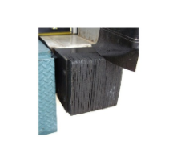 |
- Dock Face: It is the outside wall of the area of the dock door.
| - Dock Leveler: (also known as pit leveler and dock plate) is located at the entrance of the dock and can be up and down to accommodate varying trailer floor heights. They could be manually, hydraulically, or electrically operated plates. | 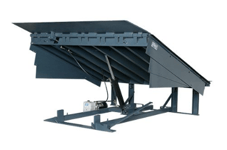 |
- Dock Leveler Capacity: The manufacturer of the dock lever is the one who considers the rating of the load according to the design, and based on the specific characteristics of the user’s application. This is called capacity. The tag rating of the manufacturer’s capacity may not reflect the gross roll overload for a specific dock leveler. If you want to know the required capacity of a dock leveler for a particular application, it will be determined by taking the GVW and applying a complexity factor to it, which will be determined by some characteristics of that application.
Some of them could be:
- The speed of the forklift moving across the dock leveler.
- The life expectancy of the dock leveler.
- The number of forklift cycles driving across the dock leveler.
- The use of three vs four-wheel lift trucks.
- The lip length.
- The loading slope above or below dock level.
- Whether there are attachments on the front end of the lift truck.
- The heaviest forklift and load, usually named GVW, is driven across the dock leveler.
To determine the capacity of the dock leveler required for a particular application, the one to help you would be the authorized sales representative of the manufacturer.
- Dock Leveler Deck: The most important part of the structure that is driven over is the deck assembly. To have traction at the different working angles, most of the decks have some type of anti-skid surface. Working angels:
-The end of the dock leveler that is furthest from the transport vehicle
-The deck assembly pivots at the back end of the dock leveler and
-The dock leveler has a hinged lip attached to the other end.
| - Dock Lifts: It is mainly used to load/unload material from trucks that need to be moved to a dock or ground elevation. A lift whose travel is normally 5 feet (1524 mm) or less. | 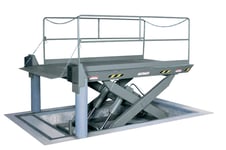 |
- Dock-Locks: Read vehicle restraint.
- Dock Pit: It accommodates the pit leveler (dock leveler) through the recessed opening in the building’s floor. In the embedded concrete, most pits are lined along the edges with structural steel angels.
- Dock Plate: It is a ramp made of metal, movable, that permits access to a trailer or a rail car.
| - Dock Seal: A rubber or canvas covering that elongates out from a dock face. It seals the gap between the trailer’s entrance and the dock and is made of rubber or canvas, which extends out from a dock face. | 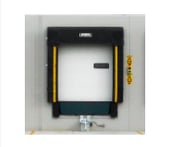 |
| - Dock Shelter: It covers the space between the door of a truck or a rail car at the warehouse. |  |
- Driveway: It is where the vehicle being transported is parked in front of the dock (the surface). It may be horizontal or could be sloped toward or away from the dock. Concrete is the material typically used, as well as asphalt or gravel.
| - EOD (Edge of Dock Leveler): It is a design of dock leveler principally to be face-mounted on the leading edge of a dock, but it can be pit-mounted as well. | 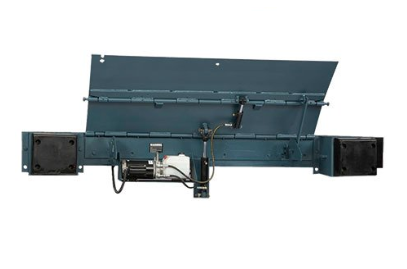 |
- Flip Lip: A way of lip extension that uses the energy left over when the dock-lever deck has come to the fully raised position and then flips the lip out. The dock board is then walked down with the lip already in an extended position.
- Gross Vehicle Weight (GVW): It is so-called when you mix the weight of both materials: Handling equipment (lift truck, pallet jack, etc.) and the load, so it could be said that it is the maximum weight moving across the dock leveler.
- Horizontal Operating Range: A way to refer to the horizontal distance that exists between the face of the dock bumper and the limitation surface of a vehicle restraint.
ICC Bar Restraint: It is a vehicle restraint that when engaged by the rear impact guard (RIG) of a transport vehicle, prevents movement of such vehicle away from the pier structure.
|
- Industrial Vehicles: These could be: - Forklift trucks |
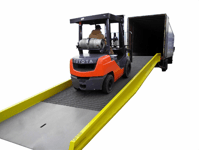 |
- Lifter Arm: If using mechanical levelers, it would be a lifting device during deployment, frequently using a roller and a spring tension which will raise the main portion of the dock leveler. Also used in describing, during its deployment, the lever arm used to extend the lip.
- Lip: Usually made with a trade plate which is very similar to the deck.
- Load: It refers to the weight of an individual pallet on a transport vehicle. It exists, for capacity calculations.
- Loading Dock: It is called to the staging platform, where shipments would be loaded or unloaded.
| - Loading Dock Door: The outside of a building in the loading dock area. In planning and constructing a building, loading dock doors would be a very important topic. The more rapidly the dock door opens, the more control of ambient temperature and humidity there will be. When a moving object approaches the door, it opens automatically, that is the way it is equipped. | 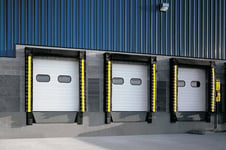 |
- Loading Dock Equipment: This equipment is used to make more accessible the loading dock area and to provide safe movement of goods. It includes:
✔ Elevating docks, dock lifts
✔ Docks levelers (pit levelers, dock plates)
✔ Dock bumpers
✔ Dock shelters
✔ Dock seals
✔ Dock lights & light communication systems
✔ Vehicle restraints
- Loading Dock Operating Personnel: It refers to the personnel related to the process of loading and unloading transport vehicles. The different activities may include industrial vehicles, vehicle restraints, dock doors, dock levelers, etc.
- Manual Operation: It refers to the manual effort of the personnel in the loading dock leveler or a vehicle restraint device in its operating position.
- Pawl: It limits the travel of the bar to only one direction when the tool is engaged with a ratchet bar.
- Pit: It is to cut out the part of the dock area to contain a dock-leveling gadget.
- Pit Steel: To protect the corners that surround the area cut out to contain the leveler instrument, this steel edging is implanted in concrete.
- Rated Load Capacity: The maximum load for which the equipment is designed by the manufacturer.
| - Rear Impact Guard (RIG): To prevent an automobile from running under a transport vehicle during a rear-end collision, a structure to the rear of a transport vehicle is attached. | 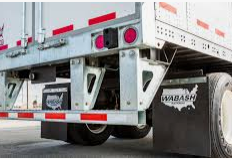 |
- Shim: Steel plates placed under the frame structure to help level pit-mounted dock levelers. When placed under the frame structure, they supply a structural load path to the building’s foundation.
- Transport Vehicle: It refers to any carrying vehicle such as a semi-trailer, truck, railcar, trailer, etc, to load or unload material by a powered or non-powered industrial vehicle or conveyors.
- Truck Restraint: Read vehicle restraint.
- Unscheduled Departure: The time when a transport vehicle leaves the dock before loading or unloading has been completed.
- Vehicle Creep: Trailer creep without control, may permit the lip of a dock leveler to become unsupported and create a hazardous gap between the transport vehicle and the dock. The movement caused when a transport vehicle away from the loading dock causes the transfer of momentum as an industrial truck decelerates when entering the vehicle and accelerates when exiting the vehicle.
- Vertical Operating Range: The altitude range of the bottom of a RIG above the driveway engaged by the vehicle restraint.
| - Vehicle Restraint: Also known as truck restraint and dock-lock. Vehicle restraints, keep a parked vehicle locked safely in place avoiding premature vehicle drive-off and creeping, reducing the risk of accidents or damage around the loading bays. | 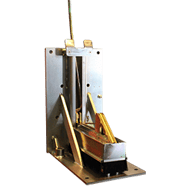 |
- Walk Out Lip: As the board is lowered into position, this style of dock leveler is designed to extend the lip section.
| - Wheel Chocks: To avoid accidental trailer movement, these blocks which can be made of rubber, wood or metal, are placed in front of, between, or behind truck wheels. |  |
- Wheel Restraint: A constraint vehicle that engages the wheels (one or several) of a transport vehicle avoiding when the vehicle is away from the dock structure, uncontrolled movement.
Overhead Door Co. of Central Jersey has product specialists ready to help you with the process of selecting the best loading dock equipment and/or commercial & industrial overhead doors for your project. We are always ready to fix, upgrade, service, and assist you.
We have been selling, installing, and servicing overhead door and loading dock products in the Central Jersey area since 1972 – for over 50 years.
We are conveniently located on Route 202 South at River Road in Branchburg, NJ. Call us today at 908-722-5785 or email us at commercial@overheaddoorco.com.












